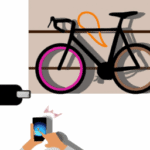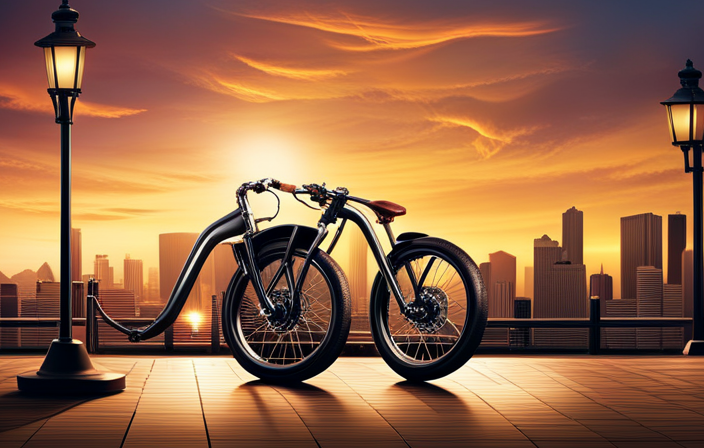As an avid electric bike enthusiast, I often find myself pondering the best way to charge my trusty steed.
In this informative article, I will share my knowledge and expertise on how to charge your electric bike efficiently and effectively. From understanding your battery type and capacity to troubleshooting common charging issues, I will guide you through the process step by step.
So, let’s dive in and unlock the secrets to keeping your electric bike powered up and ready for your next adventure.
Key Takeaways
- Different electric bike batteries require specific care instructions for charging.
- It is important to gather the necessary charging equipment and choose a compatible charger.
- Monitoring the charging progress and following the recommended charging time and frequency are crucial.
- Troubleshooting common charging issues and properly maintaining the battery are essential for optimal performance.
Understand Your Battery Type and Capacity
Understanding your battery type and capacity is key to properly charging your electric bike. Battery maintenance is crucial in maximizing battery life and ensuring optimal performance. Electric bike batteries come in different types, such as lithium-ion, nickel-metal hydride, and lead-acid. Each type has its own charging requirements, so it is important to consult the manufacturer’s guidelines or the user manual to determine the specific needs of your battery.
Lithium-ion batteries are the most common type found in electric bikes due to their high energy density and long lifespan. These batteries require regular charging to maintain their capacity and should not be fully discharged before recharging. On the other hand, nickel-metal hydride batteries are less common and have a lower energy density. They can be charged using a slow or fast charger, but it is important to avoid overcharging.
Lead-acid batteries, while less common in electric bikes, require specific care to maximize their lifespan. These batteries should be kept at full charge whenever possible and should not be discharged below 50% to prevent sulfation.
Understanding your battery type and capacity is crucial for proper battery maintenance and maximizing battery life. By following the recommended charging guidelines, you can ensure that your electric bike battery performs optimally and lasts as long as possible.
To gather the necessary charging equipment, you will need to have a charger that is compatible with your battery type and capacity.
Gather the Necessary Charging Equipment
First, you’ll need to gather the necessary equipment for charging your e-bike. To properly charge your electric bike and ensure its longevity, it is important to understand battery maintenance and choose the right charger.
When it comes to battery maintenance, you should follow the manufacturer’s guidelines on charging and discharging cycles. Overcharging or undercharging can negatively impact the battery’s lifespan.
Additionally, it is crucial to choose a charger that is compatible with your specific e-bike model. The charger should have the correct voltage and amperage to safely and efficiently charge your battery. It is recommended to use the charger provided by the manufacturer or a charger specifically designed for your e-bike brand.
Once you have gathered the necessary charging equipment, you can move on to finding a suitable charging location. This will ensure that your e-bike is always ready for your next ride without any hassle.
Find a Suitable Charging Location
To find a suitable charging location for your e-bike, you’ll want to consider factors like accessibility and proximity to a power source. Here are four key considerations when choosing the right spot to charge your electric bike:
-
Accessibility: Look for a location that is easily accessible, both for you and your bike. It should be a place where you can safely park your bike and easily connect it to the charger.
-
Proximity to a Power Source: Make sure the charging location is close to a power source. This will ensure that you have a reliable and efficient charging experience. Look for outlets or charging stations that are conveniently located near your regular biking routes.
-
Safety: Choose a location that is secure and well-lit. This will help prevent any potential theft or damage to your bike while it is charging. Consider public places, bike racks, or designated charging stations that provide a safe environment.
-
Charging Etiquette: Be mindful of others when charging your e-bike. Avoid blocking access to outlets or charging stations, and ensure that you are not inconveniencing others who may also need to charge their bikes.
Once you have found a suitable charging location, it’s time to connect the charger to your electric bike.
Connect the Charger to Your Electric Bike
Once you’ve found a suitable charging location, it’s time to connect the charger to your e-bike.
Understanding battery capacity is crucial in ensuring a successful and efficient charging process. Before connecting the charger, make sure to check the battery capacity of your e-bike. This information can usually be found in the user manual or on the battery itself. Knowing the battery capacity will help you determine the appropriate charging time required to fully recharge your e-bike.
Next, it is important to choose the right charging cables. Different e-bike models may require different types of charging cables. It is recommended to use the charging cable that came with your e-bike, as it is specifically designed for your model and ensures optimal charging performance. If you need to purchase a new charging cable, make sure to choose one that is compatible with your e-bike’s charging port and voltage requirements.
Once you have the correct charging cable, simply plug one end into the charging port on your e-bike and the other end into a power outlet. Ensure a secure connection and make sure the charger is properly plugged in.
With the charger connected, you can now monitor the charging progress and keep an eye on the battery level.
Monitor the Charging Progress
To monitor the charging progress, keep an eye on the battery level while the charger is connected. This ensures that you can optimize the charging efficiency and have a clear understanding of how much longer it will take for your electric bike to be fully charged.
Here are four reasons why monitoring the charging progress is important:
-
Peace of Mind: By monitoring the battery level, you can have peace of mind knowing that your electric bike is charging properly. This allows you to go about your day without worrying about whether your bike will have enough battery power for your next ride.
-
Time Management: Keeping an eye on the charging progress helps you manage your time effectively. You can plan your activities accordingly, knowing how long it will take for your bike to be fully charged and ready for use.
-
Battery Health: Monitoring the charging progress allows you to observe any abnormalities in the battery level. If you notice any sudden drops or inconsistencies, it could indicate a problem with the battery that needs attention.
-
Efficiency Optimization: By monitoring the charging progress, you can make adjustments to optimize the charging efficiency. This may involve adjusting the charging settings or ensuring that the charger is connected properly.
As you continue to monitor the charging progress, it is important to follow safety precautions during the charging process. This will help ensure a safe and efficient charging experience for your electric bike.
Follow Safety Precautions During the Charging Process
Now that we understand the importance of monitoring the charging progress, let’s move on to the next crucial step: following safety precautions during the charging process. Charging an electric bike may seem simple, but it’s essential to prioritize safety to prevent any potential accidents or damage to the bike.
First and foremost, it’s crucial to use the charger provided by the manufacturer. Using an incompatible charger can result in overcharging or damaging the battery. Additionally, ensure that the charger is in good condition, with no visible signs of wear or damage.
When connecting the charger to the bike, make sure the connection is secure and free from any debris or moisture. This will prevent any potential short circuits or overheating.
To further ensure charging safety, avoid charging the electric bike in extreme temperatures, both hot and cold. Exposing the battery to extreme temperatures can negatively impact its performance and lifespan. Also, keep the charging area well-ventilated to prevent any accumulation of heat.
Lastly, never leave your electric bike unattended while charging. Although modern chargers have safety features, it’s always better to be cautious and keep an eye on the charging process.
Be Mindful of Charging Time and Frequency
It’s important to be mindful of how long and how often you charge the battery of your electric bike. Proper charging time management is crucial for maximizing the lifespan and performance of your battery.
To ensure battery capacity optimization, it is recommended to charge your electric bike regularly, even if you haven’t fully depleted the battery. Lithium-ion batteries, which are commonly used in electric bikes, have a limited number of charge cycles. By charging your battery frequently, you can avoid deep discharges and prolong its overall lifespan.
When it comes to charging time, it is best to follow the manufacturer’s guidelines. Most electric bike batteries take around 4-6 hours to fully charge, although this may vary depending on the battery capacity and charger specifications. Avoid leaving your battery plugged in for an extended period as overcharging can lead to decreased battery performance and even potential safety hazards.
Avoid Overcharging Your Battery
Make sure you don’t leave your battery plugged in for too long to avoid overcharging and potential safety hazards. Overcharging your battery can lead to decreased battery life and even pose a fire risk.
To ensure proper battery maintenance and charging efficiency, consider the following:
-
Use a smart charger: Smart chargers are designed to automatically stop charging when the battery is fully charged, preventing overcharging. They also optimize charging efficiency by adjusting the charging rate based on the battery’s needs.
-
Set a timer: If you’re using a regular charger, it’s a good idea to set a timer to remind yourself to unplug the battery after a reasonable charging time. This will help prevent overcharging and prolong the battery’s lifespan.
By following these practices, you can maintain your battery’s health and maximize its performance. However, it’s important to note that overcharging is not the only factor that affects battery life. Other factors, such as temperature and discharge cycles, also play a role. Therefore, it’s crucial to consult your electric bike’s manual for specific battery maintenance guidelines.
Considering charging options on the go can provide convenience and flexibility.
Consider Charging Options on the Go
To ensure convenience and flexibility, you should consider different options for charging while you’re on the go. One of the most practical solutions is to invest in portable chargers. These compact devices allow you to charge your electric bike wherever you are, without the need for a fixed charging station. Portable chargers come in various sizes and capacities, allowing you to choose the one that best suits your needs.
There are two main types of portable chargers: wall chargers and solar chargers. Wall chargers are the most common option and can be plugged into any standard electrical outlet. They are lightweight and easy to carry, making them ideal for short trips or daily commutes. Solar chargers, on the other hand, harness the power of the sun to charge your bike’s battery. They are perfect for outdoor adventures or situations where electricity is not readily available.
When selecting a portable charger, consider its compatibility with your electric bike’s battery. Some chargers are designed to work with specific bike models, while others are more universal. Additionally, pay attention to the charger’s output power, as it will determine how quickly your battery charges.
Properly store and maintain your charger to ensure its longevity and efficiency.
Properly Store and Maintain Your Charger
When properly stored and maintained, your charger will last longer and operate more efficiently. Properly maintaining your charger is crucial to prevent charger damage and ensure its longevity. Here are some tips to help you maintain your charger:
-
Keep it clean: Regularly clean your charger to remove any dust or debris that may accumulate on the surface. This will prevent any potential damage caused by dirt or grime.
-
Store it in a cool, dry place: Exposing your charger to extreme temperatures or moisture can lead to damage. Store it in a cool, dry place to protect it from any potential hazards.
-
Avoid overcharging: Overcharging your charger can cause it to overheat and reduce its lifespan. Always unplug your charger once your device is fully charged to prevent any unnecessary strain.
-
Handle with care: Treat your charger with care and avoid bending or twisting the cables. This will help prevent any damage or fraying that could occur.
By following these simple steps, you can properly maintain your charger and prevent any potential damage.
Now, let’s move on to the next section about how to extend battery life with proper charging habits.
Extend Battery Life with Proper Charging Habits
By following these simple charging habits, you can extend the life of your battery and ensure optimal performance. To maximize battery performance and optimize charging habits, it’s important to understand the dos and don’ts of charging your electric bike. Here are some key tips to keep in mind:
| Dos | Don’ts | Why |
|---|---|---|
| Use the charger provided | Use a charger from another device | Chargers are specifically designed for your electric bike and using a different one may cause damage to the battery. |
| Charge your battery regularly | Let your battery discharge completely | Frequent charging helps maintain the battery’s capacity, while fully discharging it can lead to decreased performance over time. |
| Charge in a cool, dry place | Charge in extreme temperatures or humidity | Exposing your battery to extreme conditions can shorten its lifespan and affect its performance. |
| Unplug the charger after it’s fully charged | Leave the charger plugged in for extended periods | Overcharging can lead to overheating and reduce the battery’s overall lifespan. |
Troubleshoot Common Charging Issues
If you’re experiencing issues with charging, there are several troubleshooting steps you can take to resolve the problem efficiently.
First, check the charging cable and make sure it is properly connected to both the electric bike and the power source. Sometimes, a loose connection can prevent the battery from charging properly.
Next, inspect the charging port on your electric bike for any debris or damage. A dirty or damaged port can also interfere with the charging process.
If everything looks good so far, try using a different power outlet or charging cable to rule out any issues with the power source or cable.
Additionally, it’s important to note that extreme temperatures can affect battery performance. If you’re trying to charge your electric bike in extremely hot or cold conditions, it may not charge efficiently.
Lastly, make sure you are using the correct charger for your electric bike’s battery. Using an incompatible charger can lead to charging issues or even damage the battery.
Seek Professional Assistance if Needed
In case the problem persists, it’s best to consult a professional for assistance. When troubleshooting common charging issues with your electric bike, there may come a point where you need to seek professional advice. While many charging problems can be resolved through basic troubleshooting techniques, there may be underlying issues that require the expertise of a professional. This is especially true if you have tried various troubleshooting methods without success or if you are unsure about how to proceed.
Professional assistance can provide you with a deeper understanding of the problem at hand and offer tailored solutions to get your electric bike charging properly. They have the knowledge and experience to diagnose complex issues and can recommend specific actions to resolve them. Additionally, seeking professional advice can prevent you from accidentally causing further damage to your electric bike or its charging system.
By consulting a professional, you can save time, effort, and potentially money in the long run. They can guide you through the troubleshooting process, helping you identify any potential issues and providing step-by-step instructions for resolving them. So, if you’re experiencing persistent charging problems with your electric bike, don’t hesitate to reach out to a professional for the assistance you need.
Now, let’s explore alternative charging methods to keep your electric bike powered up.
Explore Alternative Charging Methods
To keep your electric bike powered up, you can try out different alternative charging methods. While the most common way to charge an electric bike is by plugging it into a wall outlet, there are other options available that can provide convenience and flexibility. One alternative charging method is using portable chargers. These compact devices allow you to charge your electric bike on the go, making it perfect for long rides or when you’re away from a power source.
Here is a table showcasing some popular portable chargers for electric bikes:
| Portable Charger | Capacity | Weight | Price |
|---|---|---|---|
| Charger A | 10,000mAh | 0.5 lbs | $50 |
| Charger B | 20,000mAh | 1 lb | $80 |
| Charger C | 30,000mAh | 1.5 lbs | $100 |
| Charger D | 40,000mAh | 2 lbs | $120 |
With these portable chargers, you can easily charge your electric bike wherever you are, ensuring you never run out of power. Additionally, some portable chargers even have multiple output ports, allowing you to charge other devices simultaneously.
Enjoy the Benefits of a Fully Charged Electric Bike
After exploring alternative charging methods for my electric bike, I cannot stress enough the importance of regular charging. Not only does it ensure that I have enough power for my rides, but it also maximizes the performance of my bike’s battery.
One of the key benefits of regular charging is the extended lifespan of the battery. By consistently charging my electric bike, I prevent the battery from fully discharging, which can cause irreversible damage. Additionally, regular charging helps maintain the battery’s capacity, allowing me to enjoy longer rides without worrying about running out of power.
Another advantage of regular charging is improved performance. When the battery is fully charged, it delivers maximum power to the motor, resulting in enhanced acceleration and speed. This not only makes my rides more enjoyable but also allows me to tackle steep inclines or challenging terrains with ease.
Furthermore, regular charging ensures that I always have a reliable means of transportation. By keeping my electric bike charged, I eliminate the risk of being stranded with a dead battery. Whether it’s a quick trip to the store or a long-distance adventure, I can confidently rely on my fully charged electric bike.
Frequently Asked Questions
What are the different types of electric bike batteries?
There are several types of electric bike batteries, but one of the most common ones is the rechargeable lithium battery. These batteries offer several advantages, including high energy density, longer lifespan, and lighter weight compared to other battery types.
However, they also have some disadvantages, such as being more expensive and requiring careful handling to avoid damage.
Overall, rechargeable lithium batteries are a popular choice for electric bikes due to their efficiency and performance.
How long does it typically take to fully charge an electric bike battery?
Charging an electric bike battery is like watching paint dry, only slightly more exciting.
The speed at which your battery charges depends on a few factors. The first is the charging speed of your electric bike, which can vary from model to model. Additionally, the capacity of your battery and the level of charge it currently has will affect the charging time.
On average, it takes around 4-6 hours to fully charge an electric bike battery.
Can I use any charger to charge my electric bike battery?
Using a compatible charger is important when charging your electric bike battery. It ensures efficient and safe charging.
To properly charge your battery, make sure to connect the charger to a power outlet and then plug it into your bike’s charging port.
Avoid common mistakes like overcharging or using a charger that is not specifically designed for your bike’s battery.
It is recommended to follow the manufacturer’s guidelines for the recommended charging time.
What should I do if my electric bike battery is not charging properly?
If your electric bike battery is not charging properly, there are several troubleshooting tips you can try.
One common issue is a faulty charger, which can prevent proper charging.
Another issue could be a loose connection between the charger and the battery.
Additionally, extreme temperatures can affect the charging process.
It’s important to ensure that you are using the correct charger for your specific electric bike model and to follow the manufacturer’s guidelines for charging.
Are there any safety precautions I should take while charging my electric bike battery?
When it comes to charging your electric bike battery, it’s crucial to prioritize safety measures.
Firstly, ensure that you are using the charger provided by the manufacturer to avoid any compatibility issues.
Additionally, always charge your battery in a well-ventilated area, away from flammable materials.
Avoid overcharging by disconnecting the charger once your battery is fully charged.
Finally, be cautious of common charging mistakes such as using damaged cables or leaving your battery unattended while charging.
Conclusion
After understanding how to charge my electric bike, gathering the necessary equipment, and finding a suitable location, I can confidently say that the process is simple and efficient.
By monitoring the charging progress and troubleshooting any issues, I can ensure that my bike is always ready to go. If needed, seeking professional assistance is always an option.
Exploring alternative charging methods can also provide flexibility.
With a fully charged electric bike, I can now enjoy the benefits of a convenient and sustainable mode of transportation.
















